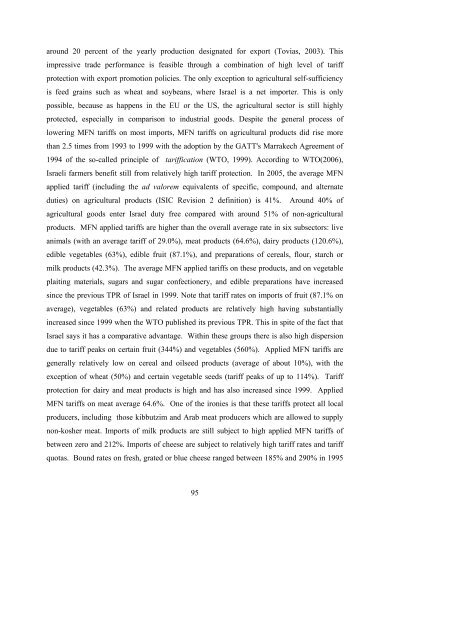PDF, GB, 139 p., 796 Ko - Femise
PDF, GB, 139 p., 796 Ko - Femise
PDF, GB, 139 p., 796 Ko - Femise
Create successful ePaper yourself
Turn your PDF publications into a flip-book with our unique Google optimized e-Paper software.
around 20 percent of the yearly production designated for export (Tovias, 2003). This<br />
impressive trade performance is feasible through a combination of high level of tariff<br />
protection with export promotion policies. The only exception to agricultural self-sufficiency<br />
is feed grains such as wheat and soybeans, where Israel is a net importer. This is only<br />
possible, because as happens in the EU or the US, the agricultural sector is still highly<br />
protected, especially in comparison to industrial goods. Despite the general process of<br />
lowering MFN tariffs on most imports, MFN tariffs on agricultural products did rise more<br />
than 2.5 times from 1993 to 1999 with the adoption by the GATT's Marrakech Agreement of<br />
1994 of the so-called principle of tariffication (WTO, 1999). According to WTO(2006),<br />
Israeli farmers benefit still from relatively high tariff protection. In 2005, the average MFN<br />
applied tariff (including the ad valorem equivalents of specific, compound, and alternate<br />
duties) on agricultural products (ISIC Revision 2 definition) is 41%. Around 40% of<br />
agricultural goods enter Israel duty free compared with around 51% of non-agricultural<br />
products. MFN applied tariffs are higher than the overall average rate in six subsectors: live<br />
animals (with an average tariff of 29.0%), meat products (64.6%), dairy products (120.6%),<br />
edible vegetables (63%), edible fruit (87.1%), and preparations of cereals, flour, starch or<br />
milk products (42.3%). The average MFN applied tariffs on these products, and on vegetable<br />
plaiting materials, sugars and sugar confectionery, and edible preparations have increased<br />
since the previous TPR of Israel in 1999. Note that tariff rates on imports of fruit (87.1% on<br />
average), vegetables (63%) and related products are relatively high having substantially<br />
increased since 1999 when the WTO published its previous TPR. This in spite of the fact that<br />
Israel says it has a comparative advantage. Within these groups there is also high dispersion<br />
due to tariff peaks on certain fruit (344%) and vegetables (560%). Applied MFN tariffs are<br />
generally relatively low on cereal and oilseed products (average of about 10%), with the<br />
exception of wheat (50%) and certain vegetable seeds (tariff peaks of up to 114%). Tariff<br />
protection for dairy and meat products is high and has also increased since 1999. Applied<br />
MFN tariffs on meat average 64.6%. One of the ironies is that these tariffs protect all local<br />
producers, including those kibbutzim and Arab meat producers which are allowed to supply<br />
non-kosher meat. Imports of milk products are still subject to high applied MFN tariffs of<br />
between zero and 212%. Imports of cheese are subject to relatively high tariff rates and tariff<br />
quotas. Bound rates on fresh, grated or blue cheese ranged between 185% and 290% in 1995<br />
95

















